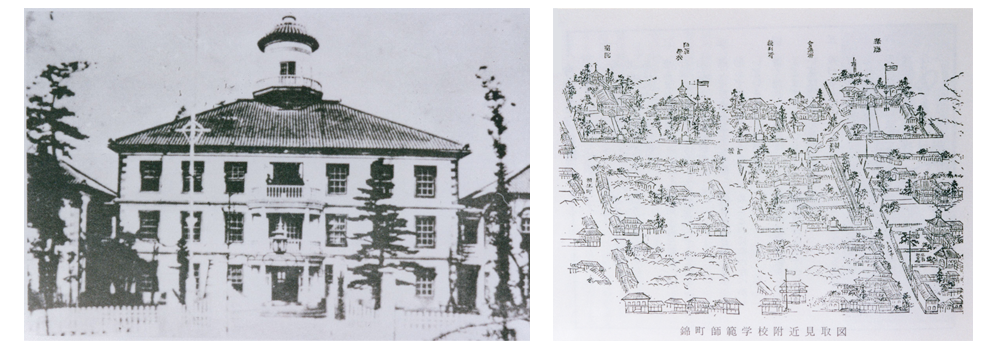Exhibition (collection)
● Permanent exhibition
Kitenkan exhibit Corner
Exhibition Background / Outline
Visit this exhibit for a peek into the Kitenkan, the Shōheikō (Edo shogunate-run institution) branch school that would develop into the University of Yamanashi. In this exhibition area, museum-goers will find fascinating archival evidence from the late-eighteenth-century onward, the Kitenkan monument, an ink impression of the institution’s motto, and more.

About “Kitenkan”
The origin of the University of Yamanashi dates back to the Edo period.
The Tokugawa Shogunate opened the Shohei School (Shoheisaka Gakuinsho) in Edo, and it was the center of the pedagogical policy of the Shogunate. The Shohei School was responsible for the education of the vassals of the shogunate. Branch schools were established in the various areas under the direct control of the shogunate, but the branch that was given the highest priority from the center of the shogunate was the Kitenkan in Kofu. This Kitenkan later became the University of Yamanashi.
Kitenkan began as “Kofu Gakusho,” established in the Kofu office for controlling the area from 1796 (the 7th year of Kansei) to 1797. Buryou Tomita, a vassal who served as the Kofu Katte Kobushin, was the professor. Plans for construction of a new school building began in 1803 (the 3rd year of Kyowa), and the new building was completed in 1805 (the 2nd year of Bunka). The school was located in the Otemon South 3rd Town in the Kofu Castle district (1 town is about 109 square meters). Jussai Hayashi, from a family of famous neo-Confucian scholars, became the head of this new school and named it Kitenkan. A framed motto written by Sadanobu Matsudaira was displayed. In 1843 (the 14th year of Tenpo), a large-scale new school building was constructed again in the south of Otemon. The school system was also significantly reformed, and two heads of this school were dispatched from the main branch of the Shohei School in Edo. In commemoration of the construction of this second school building, the “Jushin Kitenkan Monument” was erected. The text was written by Kashu Tomono (Head of Kitenkan), the calligraphy was by Asano Nagayoshi (pen name Asano Baidou) from the Kofu office for controlling the area, and the engraving was done by Teiu Hayashi, the schoolmaster. Since then, vassals from the Kaimei (enlightenment) group that would lay the foundations for modernization and globalization (Tadanari Iwase, Naoyuki Nagai, Ko Yatabori, Taichi Tanabe, Masanao Nakamura, etc.) were appointed as heads of the Kitenkan one after another.
The Kitenkan was temporarily closed during the first period of the Meiji Restoration, but it was reopened soon, and after that the location of the school and the name changed repeatedly. The name became Kaichi School, Normal School (Shihan School), and so on, and for a period in the late 1870s to early 1880s (Meiji 10s) the name Kitenkan was restored. Crossing paths historically with Yamanashi Prefectural Kofu First High School, Hikawa High School and the Yamanashi Prefectural Central Hospital, the history of the Kitenkan has continued unbroken to the current Faculty of Education of the University of Yamanashi.
Kitenkan
The name “Kitenkan” comes from the Book of Documents (Shūjīng, in Japanese pronounced Shokyou), the oldest historical record in China. In this work, we are told to modestly keep the five cardinal Confucian virtues. Modestly keeping the five virtues is pronounced in Japanese “Shinkigoten.” In Cai Shen (Shuzi’s disciple)’s works the five virtues are explained as follows: “The relationship between parents and children is based on filial piety; the relationship between a prince and his vassals is based on justice; the relationship between husband and wife is based on courtesy; the relationship between the old and the young is based on order, and the relationship between friends is based on faith.
Therefore, “Kiten” means learning the path of the five virtues, and the Kitenkan is a place where people gather to become greater as humans.



